
Good thing Henry Ford wasn’t one of the historical figures represented today, in real live action, at Wadsworth Elementary’s “Who’s Who in History” day. Ford, you see, is the guy who once claimed that “history is more or less bunk.” Teachers, students, and many other participants in Wadsworth’s day proved him wrong. History is as alive and real as its storytellers choose to make it.
And Robin Dupont, the principal at Wadsworth, found a way to turn everyone into a story teller—with a historical purpose: She and her staff, with help from community members, drew up lists of historical figures, alive and dead, men and women, all sorts of races and religions and nationalities: Barbara Jordan, Betty Shabbaz, Maya Angelou, Betsy Ross, Mother Teresa, Malcolm X, Thurgood Marshal, Albert Einstein, Mahatma Gandhi, John Kennedy, Barbara Bush, Mansa Mousa (the 14th century king of Mali), and many more. They threw in a few symbols, too, like Lady Liberty and Mona Lisa. They invited school staffers and community members to be the historical figures, dressing up like them, talking like them, knowing enough about them to give a brief sum-up of their lives. And they invited them all to be at the school for a few hours today.
The students’ part was to put the live puzzle together: the more students from each individual class were able to identify the historical figures—who walked around with clip boards to keep score—the more credits they accumulated for their individual classes. By day’s end, a winning class was to be nominated.

The Bush name can have that effect on people these days.
But Mrs. Bush, who’ll be 87 in June, was kind enough to answer a few questions. When asked whether Jeb Bush might jump into the Republican race for president, she said without hesitation: “I think there’s a good possibility. He’s my favorite son.” She described the younger George’s years out of office as “quite an adjustment,” and predicted that she would see one more Bush in office. Of course, she’d have to make it at least to age 92 to see that happen.
Visitors at Wadsworth today would have been greeted by Cleopatra, the last of the Egyptian pharaohs (that would be Corrine Hays, who always rules over the front desk), along with the surprising reappearance of Amelia Earhart (Cindy Cashman), the American aviator who disappeared in 1937 somewhere over the Pacific. And taking shots of them all was Alexander Wolcott (Mary Ann Suwinski, the bookkeeper at Wadsworth), the photographer credited with opening the very first photography shop in this country—and patented the very first camera. Wolcott isn’t an easy reference to figure out. And yet: “I had two kids guess me,” Wolcott- Suwinski said. “I can’t believe it.”
Susan B. Anthony and John Hancock—performed here by a woman, possibly in keeping with Hancock’s secret weekend hobby—were glimpsed walking between buildings and getting guessed out by three students. “It was so easy to figure out because she said ‘Sue’ and she fought for women’s right,” Alyssa Nesbitt, a 5th grader, said. “John Hancock was easy.” He, or she, carried a huge quill, and the famous signature was hancocked for all to see.
So it went: as you walked through the school or glimpsed inside classrooms, you could see a teacher dressed as George Washington, a counselor becoming Mahatma Gandhi (that’s Robert Ledek, better known as Mr. Bob, who’s quick with the sump-up: “Remember, your life is the message, An eye for an eye makes the whole world blind”), an aid becoming Mother Theresa (Theresa Baker), and a guidance counselor, Oatricia Carmo, literally coming out of Mona Lisa’s frame. Somewhere along the way was John Kennedy, performed—with a mask that made it difficult for him to breathe—by John Fischer, the school board member, who could remember Kennedy’s words and quote them to students. And Einstein, performed by Katrina Townsend, the district’s student services director, who had a give-away on her lapel: a prominent E=mc2.
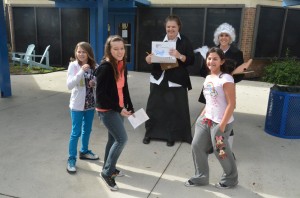
The day was the culmination of a school-wide effort to learn about historical figures, with evidence of the learning in varied forms all over the school walls. Some classes turned to biography as a comic strip. Some used graphing. Some stuck to traditional narration. It appeared that all had taken part, including the youngest students, who generally–and naturally–had a harder time placing their historical figures, especially the more recent ones. The national consciousness, no matter the age, responds differently to, say, Oprah or Pocahontas (who were among the figures studied) than it does to Paul revere and Madame Curie.
By the time students walked into the cafeteria for lunch, the stage was teeming with history’s celebrities, and the hall turned into something like an auction, where students sprang to their feet to raise their hands higher and summon one of the figures to themselves to identify him or her, and score another credit. It was history, living and breathing, despite the anachronisms. The food was still early 21st century cafeteria food, Oreos with historic fillings, and Lunchables.
![]()
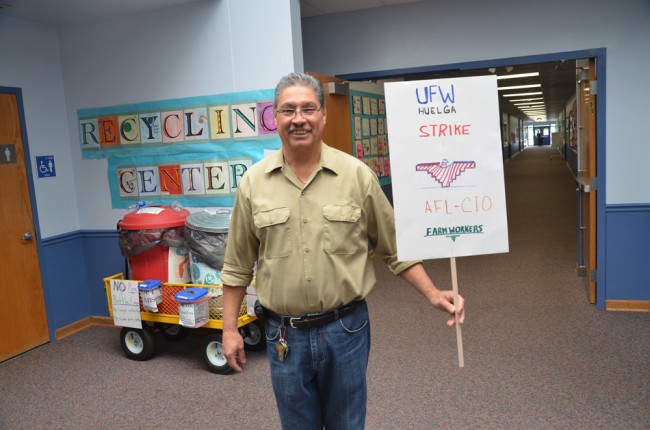
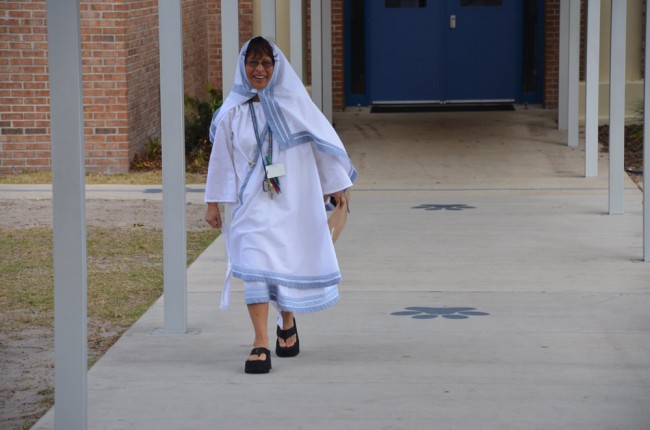
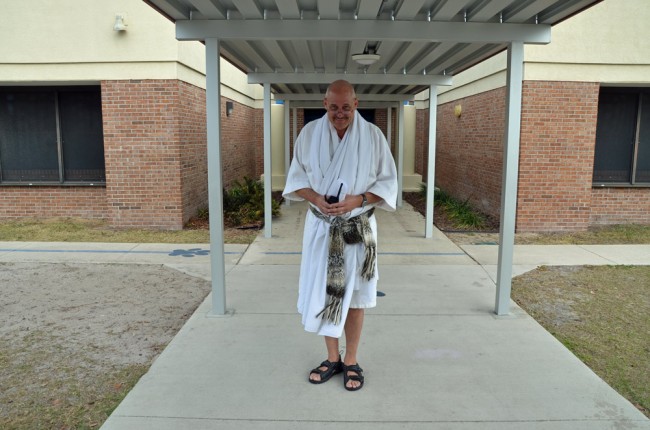
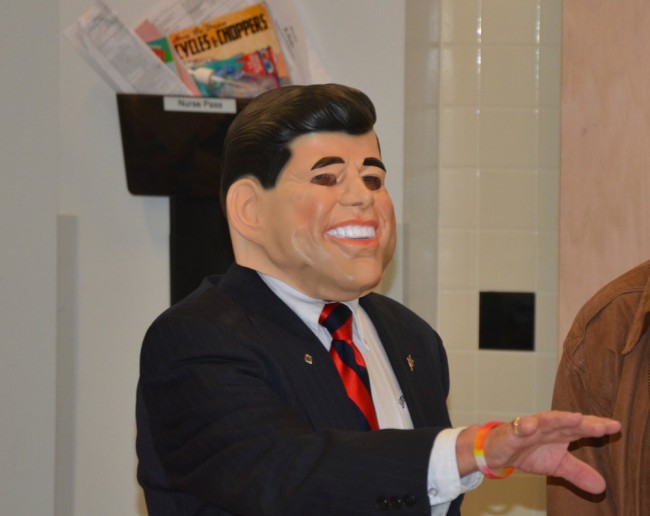
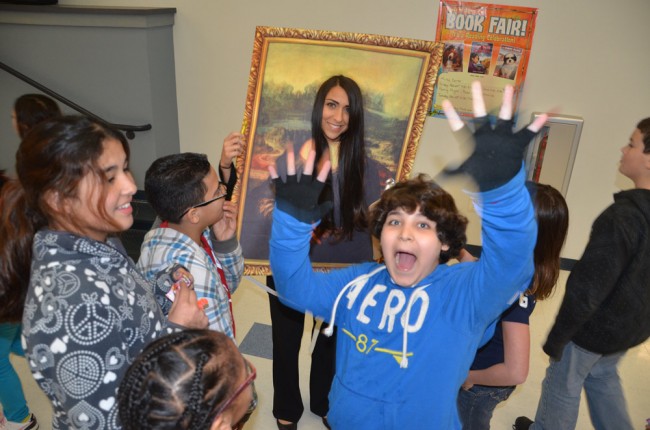




























Laura says
History comes to life!
This shows extraordinary effort to facilitate ordinary learning.
Kudos to our former “kingly” neighbor, Bert Green for pulling off the Lion of Mali.
He is a fine example of community giving back to the educational process.
I hope this activity has cultivated a desire to learn, know, and grow in each and every student.
{{* *}}
Joe says
Good Job WES!!!!
Brun says
Taking the time out to show a little history instead of just reading about it made such a huge difference to these kids. Walking down the hall with my co-worker depicting the Wright Brothers was an awesome experience. You could see the kid’s faces light up when they saw you, they were engaged and very smart about asking questions and listening to hints. I think the staff at WES did a wonderful thing and with the help of our community this event was a huge success. Hopefully, this will spread throughout the district and all of our schools will try something like this.